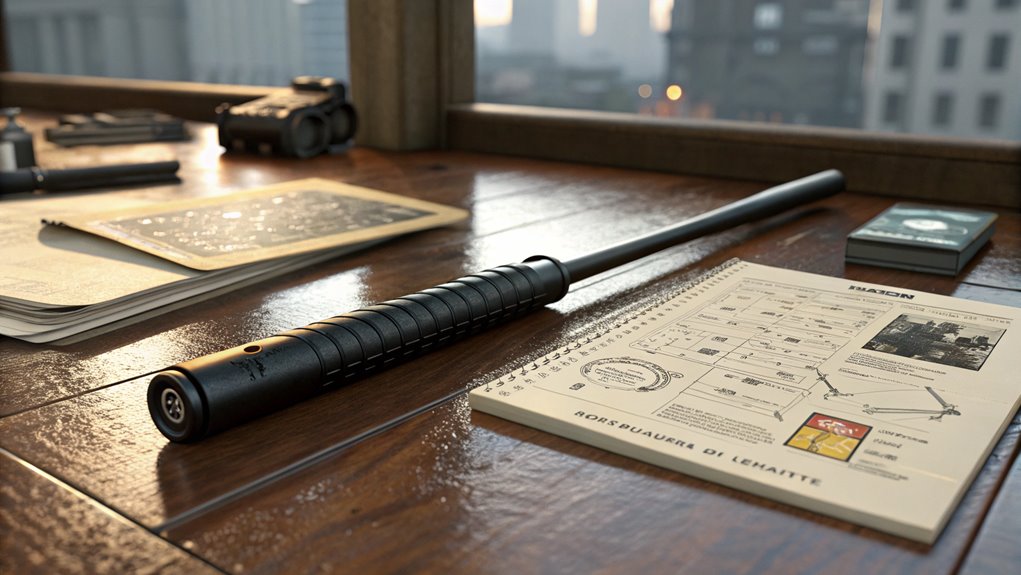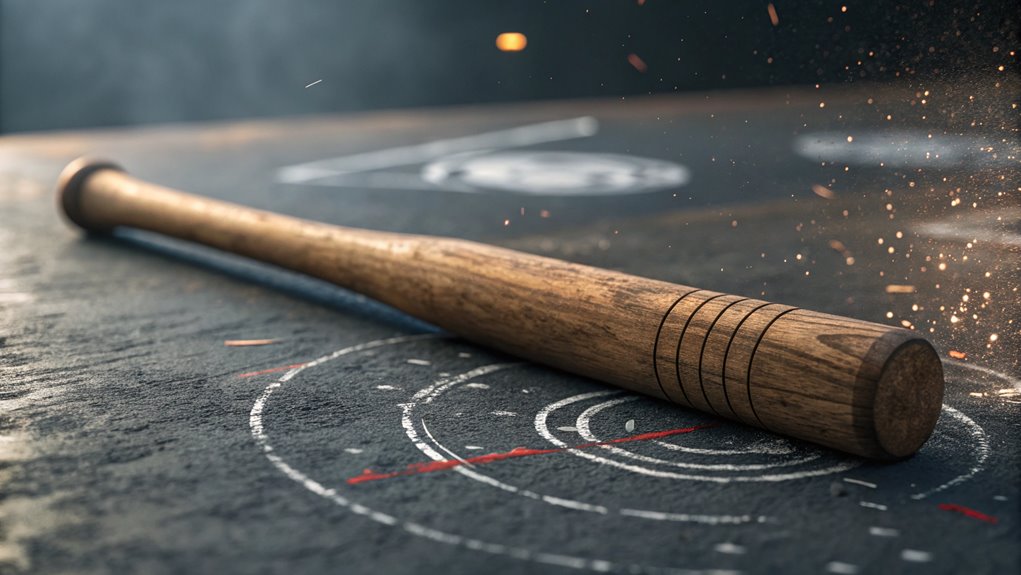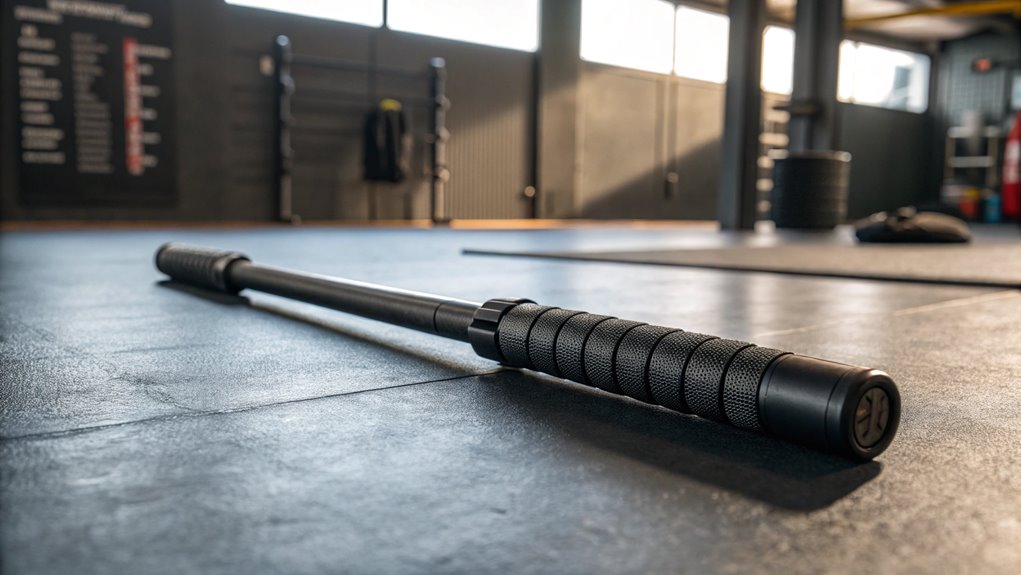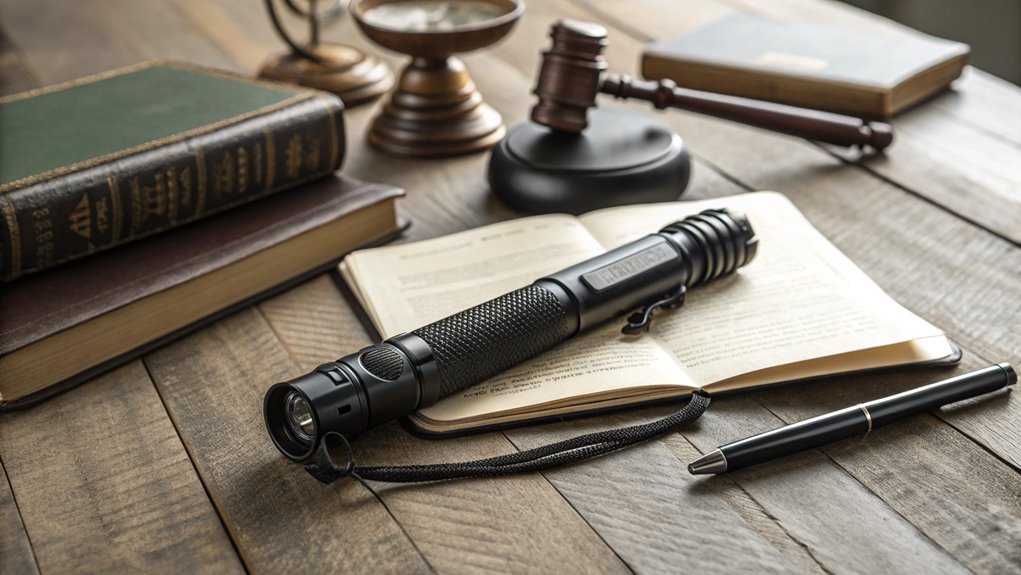Baton training for self-defense is super important because it teaches you key skills to protect yourself. You’ll need to know different grips, like the standard or reverse grip, which help you stay in control during a scary situation. Also, practicing striking techniques, like jabs and swings, allows you to target the right spots on an attacker. Don’t forget defensive moves, too; things like dodging can save you in a pinch. Plus, understanding the legal side is vital so you know what’s allowed. Stick around, and you’ll discover even more tips to enhance your self-defense game!
Understanding the Baton

When it comes to self-defense, understanding the baton is vital for effective use. You might think a baton’s just a stick, but it’s so much more! There are various baton types, each designed for specific situations. For instance, collapsible batons are compact, making them easy to carry, while fixed-length batons offer durability and a solid grip. Knowing these differences can help you choose the right one for your needs. The Automatic Expandable Steel Baton with a black handle is an example of a collapsible baton that offers convenience and ease of use.
Now, let’s chat about tactical applications. A baton isn’t just for swinging wildly; it’s about control and precision. You can use it to block an attack, create distance, or even disarm an assailant if you know what you’re doing.
The 110,000,000 volt Bad Ass Metal Stun Baton combines the functionality of a stun device, flashlight, and heavy-duty club, making it a versatile tool for self-defense.
It’s essential to practice these techniques so you can respond effectively under pressure. Imagine facing a situation where someone threatens you; you want to feel confident and ready.
Basic Grips and Stances
Mastering basic grips and stances is essential for anyone looking to effectively wield a baton in self-defense situations. When you hold your baton correctly, you gain better control, which can make a huge difference in a high-pressure moment. Let’s explore some basic grip techniques and stance variations that will set you up for success.
In addition to mastering grips and stances, it’s important to consider the compact size when collapsed, which allows for easy portability and accessibility during unexpected situations.
| Grip Type | Description | Ideal Use |
|---|---|---|
| Standard Grip | Hold the baton in the middle, palm down. | General use in self-defense. |
| Reverse Grip | Hold the baton with palm up, for surprise attacks. | Close-quarters situations. |
| Two-Hand Grip | Use both hands to grip the baton, adding stability. | When facing multiple attackers. |
| One-Handed Grip | Use one hand for quick movements and strikes. | Fast evasion and mobility. |
Striking Techniques

Effective striking techniques are essential for maximizing the baton’s potential in self-defense scenarios. When you use a baton, it’s vital to understand the different baton types available, since each has unique features suited for various situations. You’ll want to choose a baton that feels comfortable and allows you to strike effectively.
Now, let’s talk about impact zones. Knowing where to strike can make a big difference in self-defense. Aim for vulnerable areas on an attacker, like the head, knees, or hands. These zones can incapacitate someone quickly, giving you a chance to escape.
When practicing your strikes, focus on speed and precision. You can use quick jabs or powerful swings, depending on the situation. Remember to keep your wrist straight and your grip firm, so your strikes land with maximum force.
Don’t forget, it’s not just about how hard you hit, but also how well you control the baton. Practice makes perfect, so get comfortable with your techniques. Your safety is the priority, and mastering these striking skills can help you stay safe in a tough situation.
Defensive Maneuvers
After honing your striking techniques, it’s time to focus on defensive maneuvers that can keep you safe while using a baton.
You’ve got to understand that defensive tactics aren’t just about being tough; they’re about smart moves that protect you. When an attacker comes at you, your first instinct might be to swing that baton, but sometimes it’s better to dodge or deflect.
Learn how to sidestep an incoming strike or use your baton to block hits. Think of your baton as a shield, not just a weapon.
For instance, if someone lunges at you, step to the side while raising your baton to intercept their attack. This keeps you out of harm’s way while also creating an opportunity for your own counterattack.
Control and Restraint

When you’re faced with a confrontation, knowing how to apply control and restraint techniques with your baton can make all the difference. Control techniques help you manage an aggressive situation without escalating it further. For instance, using your baton to create distance can keep an attacker at bay, giving you time to think.
You can also position the baton to guide or direct an assailant’s movements, making it easier to maintain control.
Restraint strategies play an essential role as well. When someone is acting out, you might need to immobilize them temporarily. By applying strategic pressure points with your baton, you can effectively limit their movements without causing unnecessary harm.
It’s important to remember that your goal is to neutralize the threat, not to inflict pain.
Practicing these skills won’t only boost your confidence but also help you stay calm in tough situations. You’re not just swinging a baton; you’re using it as a tool to maintain safety for yourself and others.
Situational Awareness
Situational awareness is a essential skill for anyone training in self-defense with a baton. It’s all about being tuned in to your surroundings, so you can spot potential threats before they become a problem. When you walk down the street, pay attention to people around you, their movements, and your environment. This is called environmental awareness, and it’s important for keeping yourself safe.
Start by practicing threat assessment. Ask yourself questions like, “Is someone acting strangely? Are there groups of people that look aggressive?” By continuously scanning your surroundings, you’ll learn to recognize warning signs, which can help you avoid dangerous situations altogether.
Remember, it’s not just about reacting when trouble strikes. You want to be proactive. If you sense something’s off, trust your instincts and take action. This might mean crossing the street or finding a safe place to wait until the situation changes.
In self-defense, being aware can make all the difference. So, take a moment each day to observe the world around you—your safety depends on it!
Legal Considerations

Understanding the legal implications of using a baton for self-defense is just as important as being aware of your surroundings. You need to grasp the laws in your area, since they can vary widely. Some places allow batons, while others have strict use restrictions or even ban them outright. Knowing this can keep you out of serious trouble!
Here’s a quick overview of what to evaluate:
| Aspect | Details |
|---|---|
| Legal Implications | Understand local laws on self-defense |
| Use Restrictions | Check if batons are legal in your area |
| Consequences | Know what happens if you misuse a baton |
| Self-Defense Laws | Familiarize yourself with justifiable force |
Before you ever think of using a baton, remember that self-defense isn’t just about the tool; it’s about knowing when and how to use it legally. If you use it improperly, you could face legal action, which is the last thing you want when trying to protect yourself. So, stay informed and always have a clear understanding of the laws that could impact your safety.
Answers to Common Questions
What Gear Is Recommended for Baton Training?
For baton training, you’ll want to choose the right baton types, like a collapsible or fixed model. Don’t forget your protective gear, including gloves and pads, to guarantee safety during practice and learning.
How Often Should I Practice Baton Techniques?
To improve technique retention, you should practice baton techniques at least two to three times a week. Regular practice frequency helps reinforce skills, ensuring you stay proficient and confident in your abilities when needed.
Can Baton Training Improve General Fitness?
Absolutely, baton training can boost your general fitness. It combines cardio benefits with strength building, helping you enhance endurance and muscle tone. You’ll notice improvements in your overall physical health as you practice regularly.
Are There Age Restrictions for Baton Training?
When it comes to age restrictions for baton training, you’ll find youth programs usually set specific age requirements. Generally, kids as young as 8 can participate, but check with local programs for precise details.
What Is the Cost of Baton Training Classes?
The cost of baton training classes varies by location and instructor. You’ll find class pricing typically ranges from $50 to $150 per session, depending on the training locations and the duration of each class.
Bottom Line
So, whether you’re learning to wield a baton for self-defense or just want to feel a little more secure, remember that these skills can make a real difference. It’s not about being tough; it’s about being smart and prepared. You’ve got the basics down, and with practice, you can handle tricky situations with confidence. Stay aware, know your rights, and always prioritize safety. After all, being ready is key to staying one step ahead when it counts most!




